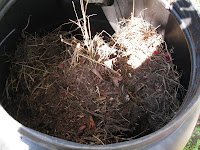You might ask why we selected a closed tumbler unit for composting when we live out in the middle of nowhere, there are no HOA covenants restricting what we do, and few neighbors to complain. The simple reason is that we live in the middle of nowhere-meaning there is lots of wildlife around. While a well balanced and managed compost pile should not have an odor, kitchen waste (even in a well managed compost set up) can attract wildlife. I would like to avoid this. I enjoy wildlife, and appreciate all the little critters... as long as they stay on their side of the line. (HEY YOU RACCOONS OUT THERE.....I'm talkin' to YOU!). Since we intend on using kitchen waste in the compost, a closed unit seemed like a good balance between having compost but keeping the critters under control. The other reason is that we have not yet put up fencing and as cute as she is, this member of the family
has the terrible habit of rolling in "stuff" that she finds. I get that she is following instinct and by bringing what she "finds" back to me she is identifying me as the head of the pack, but I really have no interest in chicken poo, dead worms, snail slime, or fermented apple peels from the compost pile being wiped all over me by a very happy and dirty doggie.Once we get fencing up, and if/when we get animals we will be building a three bin open compost system to manage the manure. For the kitchen waste however, the closed tumbler seemed the most logical way to go.
Composting is not difficult as it really is just taking what happens naturally in nature and designating where it should occur. There is a science to it however, and it is all about balance.
Compost Basics
(disclaimer: remember that I told you I am not an expert in anything)
A good compost pile is a balance of green materials and brown materials. Green materials are grass clippings, shrub clippings, food waste, coffee grounds, vegetable trimmings, manure, weeds (just be sure it has not gone to seed). Brown materials are leaves, bark, sawdust, corn stalks, fruit trimmings, cardboard (shredded), newspaper (shredded). Green materials are higher in nitrogen, brown materials are higher in carbon. A good compost set up needs a balance of both. A good compost set up needs moisture -damp not wet and air.
The natural process of decomposition depends on microbes growing in your compost. Like any living thing these microbes require food and water and oxygen to survive. You supply the food when you place materials in the compost pile. The water can come from the moisture in the materials (hint: green materials have more moisture than brown materials) or from adding additional water to your pile. When you turn or aerate your pile, you provide oxygen. The process of decomposition will generate heat, and this is a good thing. The compost needs to be at a minimum of 120 degrees, and can reach 150-170 degrees depending on how active the set up is. Keep in mind, that when you turn your pile, you will be releasing some of the heat that has built up. Food wastes should ideally be placed in the center of the pile and covered with green materials after addition, so you will want to add materials to the set up in larger amount instead of numerous small additions (i.e. collect the materials for several days and then add it all at once). An compost pile, or open bin should be at least 3' * 3' (according to most popular sources) to be able to reach the optimum temperature. If you use a closed system the heat will be more concentrated. The key will be to not overfill the container so that there is still air flow through the materials.
Too much carbon and the process of decomposition will be very slow, too much nitrogen and the pile will generate an odor.
For our first try in the tumbler we added:
Corn Husks from July
Apple Peels from September
Garden Waste (weeds, old mulch) from June
Kitchen Waste (mostly coffee grounds) from August and September
and since we were adding mostly brown materials and needed some nitrogen, a couple of shovels of regular ole' dirt.
Also since we added mostly brown materials which are generally lower in moisture and much of ours was dried garden waste and dried corn husks, we used the hose to spray down each layer (except the apple peels).
Since the decomposition process depends on reaching a certain temperature, the overall process in faster in warmer weather and can pretty much be suspended in the cold of winter. A quick glance at Internet resources shows that a tumbler the size of ours (55 gallons) should take 3-4 weeks to break down into usable compost. Given the coolness of the autumn evenings right now, my guess is we will be on the outside of 4 weeks if not longer.
If we are lucky we might get two batches of compost prepared before winter halts the natural process for the year. I'm still wondering how to best collect kitchen waste in order to be able to add it to the composter in larger batches; Guess more Internet research is in order.





No comments:
Post a Comment